ISSN ONLINE(2319-8753)PRINT(2347-6710)
ISSN ONLINE(2319-8753)PRINT(2347-6710)
Praveen Mathew1, Jeevan Jacob1, Leni Stephen3, Thomas Paul3
|
| Related article at Pubmed, Scholar Google |
Visit for more related articles at International Journal of Innovative Research in Science, Engineering and Technology
With the rapid evolution, the construction needs and demolition wastes has increased substantially. These wastes will possess serious environmental threat if not disposed of properly. Instead of using it as land fill, if it is possible to recycle it in the construction industry, it will be of fabulous support to the depleting natural stock of resources. In this study the behaviour of concrete under various percentage replacements for natural aggregate (NA) (both fine and coarse) with recycled aggregate (RA) is examined for its structural property. Properties of recycled aggregate concrete (RAC) such as compressive strength, splitting tensile strength, flexural strength and modulus of elasticity were examined. This gives a correct perception of RAC to be used as a structural material in comparison with the natural aggregate concrete (NAC).
Keywords |
| Recycled aggregate, Percentage replacement, Sustainability, Structural property. |
INTRODUCTION |
| The demand for new construction is ever-increasing with the rise in population. The use of demolition concrete waste as aggregates in concrete is prevailing from over a few years. But due to the concern over its strength from structural point of view it is not largely accepted as a structural material hence being used for insignificant works. Frondistou-Y. [1] evaluated and compared the mechanical properties of conventional concrete and RAC and concluded that the RAC has a compressive strength of at least 76% and modulus of elasticity from 60% to 100% of the control mix. Test results by Tavakoli et al. [2] indicated that the strength of recycled aggregate concrete is affected by the strength of original concrete, percentage of coarse aggregate in original concrete and the ratio of top size of aggregate in original concrete to that of recycled aggregate. In this study instead of full replacement of natural aggregates, a part replacement that offers a better structural property in comparison with the conventional concrete is ascertained. Mainly four percentage replacements were selected i.e. 0% (NAC), 20% (RAC 20), 30% (RAC 30) and 40% (RAC 40) to conduct the various tests on its property. |
II. MIX PROPORTIONING |
| The mix proportioning was done as per the Indian standards [3]. The cement used is of single origin Portland Pozzolana type with specific gravity 2.6. A. Aggregate Recycled aggregates comprises of crushed, graded inorganic particles processed from the materials that have been used in the construction and demolition concrete debris. These materials were obtained from a building which was 30 years old. The density of RA is found lower than the NA because of the porous and less dense residual mortar lumps that is adhering to its surfaces [4]. The aggregates both fine and coarse were properly graded according to the Indian standard codes [5] and then mixed with the respective natural aggregate in appropriate percentages. Specific gravity of the prepared and natural aggregate are given in Table I. The sieve analysis of the prepared aggregates were performed and found to fall in zone II for fine aggregate as per the code [5] for the purpose of reinforced concrete works. |
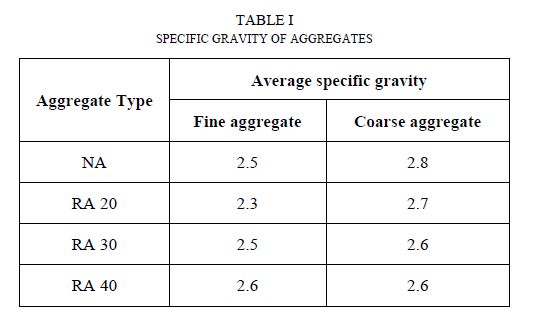 |
| B. Proportioning The compressive strength of hardened concrete which is generally considered to be an index of its other properties, depends upon many factors, e.g. quality and quantity of cement, water and aggregates; batching and mixing; placing, compaction and curing [6]. The Indian standard method of mix proportioning is followed as per the code IS 10262:2009 [3]. Four categories of concrete mixes were prepared with various percentage replacements for natural aggregate (both fine and coarse) namely, 0% (NAC), 20% (RAC 20), 30% (RAC 30) and 40% (RAC 40). In all these mixes the cement content was fixed at 370 kg/m3 of concrete and the water-to-cement ratio at 0.45. The ingredients of various mixes are given in Table II. |
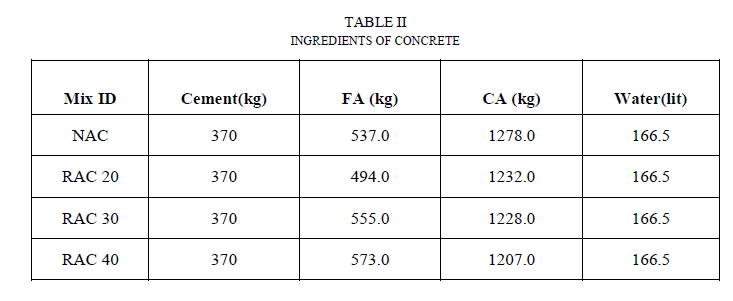 |
III. EXPERIMENTAL WORK |
| To study the properties of recycled aggregate in fresh and harden state, standard tests were conducted for both RAC NAC to correlate between them. The test conducted includes workability, strength tests and elasticity modulus tests. For this concrete cubes, beams and cylinders were cast. For each mix, three 150 mm size cubes were cast and kept moist for 28 days to determine the compressive strength. To determine the splitting tensile strength and the elastic modulus, 150 x 300 mm cylinders were cast and to determine the flexural strength, 100 x 100 x 500 mm prisms were cast. Specimens, cured in water, were tested after removal from water and while they were still in wet and surface dry condition. The testing methods of cement concrete as per IS guidelines has been used for testing recycled concrete specimens. A. Slump Test The slump test was conducted in order to determine the degree of workability obtained for RAC in comparison with the conventional concrete. The test results in Table III shows that for RAC 30 and RAC 40, the slump values were very low which would give a harsh mix. Hence it’s advisable to use admixtures which can improve its workability to be used for structural purpose. |
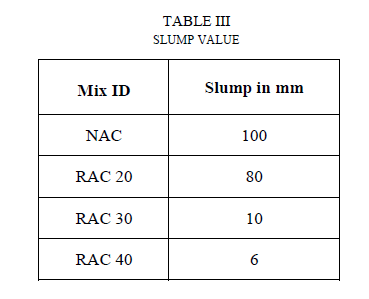 |
| B. Strength Tests The compressive strength tests were done on concrete cube specimens of size 150mm x 150mm x 150mm. The cubes were tested after a curing period of 28 days. Three cubes were tested for each mix. Reasonable good control was exercised in the laboratory during the casting, curing and testing of the specimens. The strength variation of each concrete mixes are given in Table IV. To determine the splitting tensile strength, 150 x 300 mm cylinders and for flexural strength, 100 x 100 x 500 mm prisms were cast. The results obtained are tabulated in Table IV. |
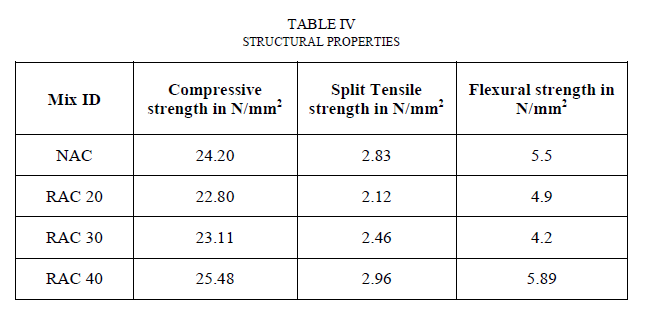 |
| The structural properties for RAC show that it’s not inferior to NAC. Hence in this way our natural resources could be preserved with the effective utilization of demolition concrete waste. But as the strength properties at higher replacement ratio were found superior, further tests need to be conducted in order to validate the results. |
| C. Modulus of Elasticity The Young’s modulus of elasticity is a constant defined as the ratio within the linear elastic range of axial stress to axial strain under uniaxial loading. In the case of concrete under uniaxial compression, it has some validity in the very initial portion of the stress strain curve which is practically linear. In usual problems of structural analysis based on linear static analysis, it is the secant modulus of elasticity that needs to be considered [7]. The secant modulus at the stress of about one-third of the cube strength of concrete is generally found acceptable in representing the average value of Young’s Modulus under service load conditions. Here the secant modulus of elasticity at specified stress level corresponding to one-third cube compression strength of concrete has been considered. |
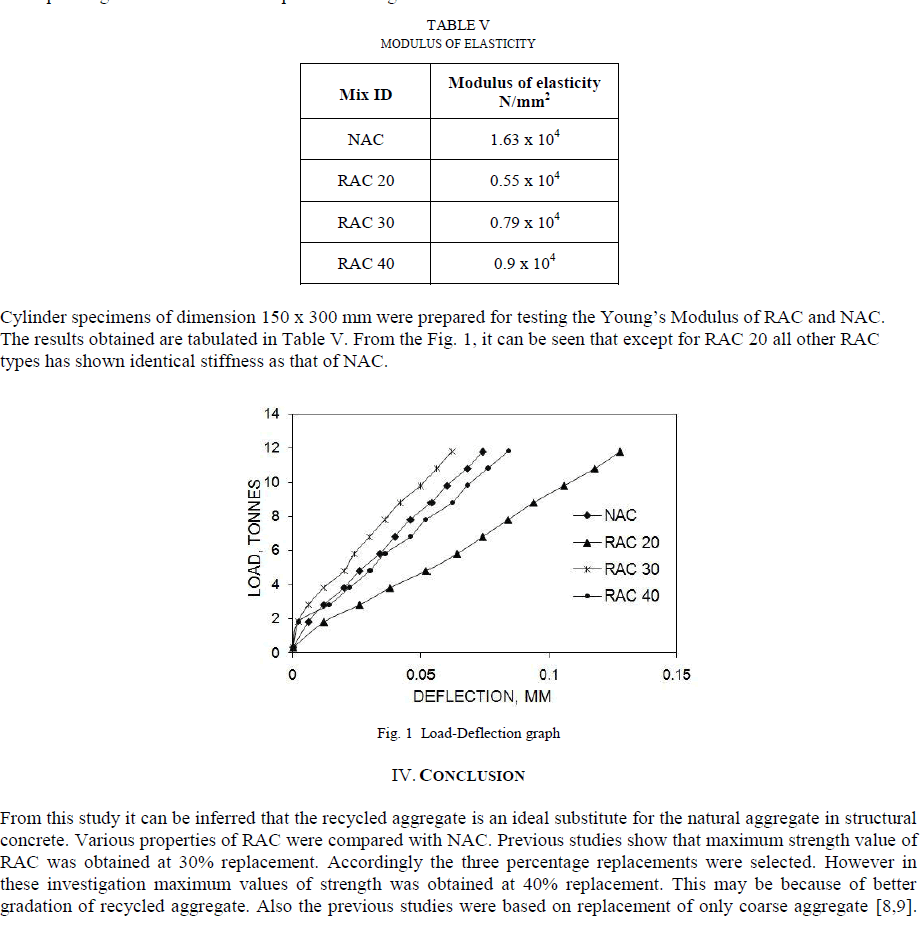 |
But in this investigation both coarse and fine aggregates were replaced. This may be one of the reasons for getting superior results.ACKNOWLEDGMENT |
| The authors express their sincere thanks to Anas M., Asha Mary Jose, Minnie Mariya James, Mumtak Pertin, Rahul M. K. and Zahir Mohammed, B.Tech students of Civil Engg. Dept., Mar Athanasius College of Engineering, Kothamangalam, Kerala, India, for their laborious efforts in this investigation. |
References |
|